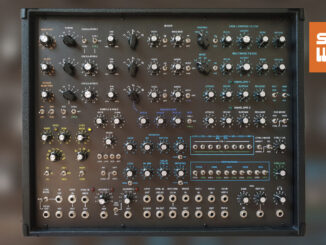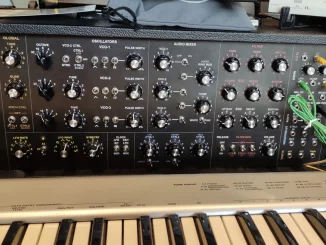NRSynth Solo is a new Oberheim SEM Synthesizer clone with extended features ahead of SynthFest France 2025.
SynthFest France brings the French Synthesizer community together in one place every year. In addition to big names like Arturia, it’s also an event for developers who pursue their passion alongside their daily jobs. One is Stephen Ingrand, who has already developed numerous vintage synth replicas/clones with add-ons.
Last year at SFF2024, NRSynth previewed the Solo, a clone/replica of the Oberheim SEM with extended features. Meanwhile, the Solo is available and will also be shown at Synthfest France 2025
NRSynth Solo
Solo is a new analog clone/replica of the Oberheim SEM Synthesizer from 1974. Every NRSynth Solo is handcrafted, not mass-produced, using through-hole components.
At its core, it uses the same circuit as the original Synthesizer Expander Module but with extended features. It has two discrete VCOs: saw and pulse and PW control and sync. Unlike the original, it has a pulse wave sub-oscillator (1 octave below VCO1) and an analog white noise generator.
The signal is then fed into a 12dB multimode filter with the same original SEM topology, including morphable lowpass, highpass, notch, and bandpass modes. The analog VCA follows the same schematics as the original Oberheim synth.
NRSynth has also tweaked the Solo modulation section. It has two analog envelope generators with switchable release from the Sequential Pro-1 Synthesizer. According to the developer, these are more punchy than the originals.
Next to the modified analog envelope, you can find an analog triangle waveform LFO like in the original SEM. Additionally, it has a digital LFO with eight waveforms + tilt with three frequency ranges and sync. Plus, you can find a sample and hold generator with sync, unlocking modulation options.
More Additional Features
Further, NRSynth Solo hosts a Eurorack-compatible patch bay with 15 patch points on 3.5mm jacks. Solo also features a new analog portamento circuit at the input for gliding sounds.
On the backside, you can find an audio output and sync input on 6.35mm, MIDI with velocity support, and a button reset. All this is mounted in a black aluminum enclosure with a black front panel and wooden side panels.
SynthFest France 2024
Here’s my video from SynthFest France 2024 about the NRSynth Solo. Please note there is no sound demo because the developer had shipping issues with the power supply.
NRSynth Solo First Impression
I’m happy to see that the Solo is now finished. In the available demos, the synth sounds lovely and juicy. It looks like an excellent alternative for those who search for an Oberheim SEM with modern features without the long hunt for a vintage device that still needs maintenance.
If the price for this boutique handmade synth is too high for you or the synth is way out of your budget, remember that Behringer is developing the 2-XM (Oberheim 2-voice). However, the latter is not based on through-hole components.
NRSynth Solo is available now on demand for 1390€ from France. The synth will not be available in shops but will be built for you on demand. It also ships with a patchbook with all the sounds from Séraphin Palmeri’s
More information here: NRSynth






Exciting ^_^
What is the black keyboard he uses (with the centre touch-pad) ?
an old Korg taktile keyboard 🙂
Why do you think the price is to high for this hand made boutic instrument by comparing it to an industrial made brand with surface mount components while the NR-Synth is all made with hand soldered through hole components ! Shouldn’t you compare apples with apples ? What other equivalent through hole component synths are made at this price ?
Musonix did a kind of clone but then made them with Surface mount and for more thant 2000.-
I think the price is good for a hand-made Boutique synth. For me, it’s reasonable because it However, there are always people who think it’s too expensive for an SEM clone without storage, etc. Before people saying buy the B version, I wrote it 😉
Uauuhh!
Thank you very much for the news!
It is a beauty, even in black.
Merci beaucoup Stephen et Séraphin!
France is deafnitely a synth-friendly country
J.
in most cases, there’s no audible difference in sound quality between through-hole and surface-mount (SMT) components, though some may perceive a difference. The “sound” difference is more likely due to variations in circuit design, component quality, or tolerance rather than the mounting method itself.
Here’s a more detailed explanation:
Misconception:
A common misconception is that through-hole components inherently “sound better” than SMT components.
Component Quality:
The quality of a component, regardless of its mounting style (through-hole or SMT), is the primary factor affecting its performance, including its sound.
Circuit Design:
Subtle differences in circuit design, such as layout and component placement, can have a greater impact on the final sound than the mounting method.
Tolerance:
Variations in component tolerances (e.g., resistors, capacitors) can also contribute to perceived differences in sound.